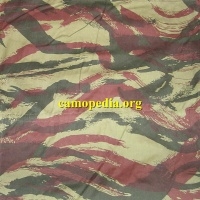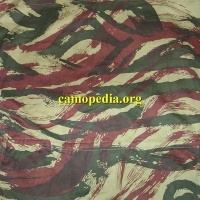Camouflage pattern Lizard (FR)
During the years of the First World War, France decided to experiment with hand-painted camouflage patterns. Certain units fighting in Europe then used these patterns. The production was managed by the army's section "Army's Section de Camouflage," led by "Eugene Corbin," and several camouflage patterns, including uneven spots, stripes, and dots, were tested for effectiveness. As in other countries, these were mainly worn by snipers and reconnaissance units operating near the front line. Due to their handmade nature, they were somewhat effective, but mass production was, of course, out of the question. And it never happened to any degree.
During the Second World War, personnel from the air force, special commandos, and similar elements of Free France wore hand-painted spotted camouflage patterns, "Denison paratrooper smocks" / Denison parachutist smocks, which were incredibly popular at the time on the other side: with the British and allies generally (Allied air force). With the growth of nationalist movements right after the Second World War, the still woefully under-equipped French army found itself in a different type of conflict. This was the First Indochina War (1946-1954).
Here, thankfully, they were supplied by their former World War II allies, leading to a number of elite French units in Indochina wearing surplus American M1942 jungle uniforms. Or even the British M42 windbreaker with camouflage. All of this was, of course, necessary to locally adjust to the desirable form of local military regulations and standards, which was often done by local French tailors.
However, in 1951, France started implementing its own unique type of camouflage pattern ("Tenue de Léopard" or "Leopard uniform"), greatly influenced by World War II and the British style known as "brush strokes." This camouflage pattern subsequently became an undeniable symbol of the French air force and local Commando units (and indeed, the French army as a whole for the rest of the century, despite the fact that this camouflage pattern stopped being used in France during the Algerian War, from about 1954-1962).
During the time period spanning from the 1960s to the early 1990s, the French armed forces (like most armed forces around Europe) wore simple olive green camouflage uniforms. However, as the age of digital and private companies in this sector approached, around the early 1980s, a number of experimental camouflage patterns began to appear (such as Texunion's in 1981 and 1983). But not until events leading to Operations "Desert Shield" and "Desert Storm" (around 1990/1991) did the French government finally embrace and adopt the idea that it might be a good idea to dress their personnel in some sort of camouflage pattern again. Therefore, from the 1990s onward, the French armed forces permanently retained this equipment, which is today their standard operational gear.
What is the Lizard Camouflage Pattern (FR)?
The first post-war camouflage patterns started appearing in France around 1951. One of the most frequently deployed patterns of this period (and also one specifically associated with the Algerian War from 1954-1962) is the type with stripes or brush strokes, often referred to (by historians and collectors) as the "Lizard" type. This term refers to the nickname given to French paratroopers during the Algerian War. The French themselves referred to it as "Tenue de Léopard" or "Leopard uniform" (or also "Tenue de saut camouflée" - "Camouflaged combat uniform") and to this series as "Camouflee de Léopard" or also "Leopard camouflage". The French "Leopard uniform" was in use from 1951 and could still be seen around the mid-1970s. For this reason, there are various designs, color combinations, and fabrics that collectors or historians may encounter relatively quickly. An attempt to categorize and classify all these types of camouflage patterns also occurred in the French military magazine "Uniformes Hors Serie" in issues fourteen and fifteen. Part of this was reprinted for public use by collector Gilles Gorgues, which can be downloaded from his pages under the name: "Vonstuck Camouflage The classification system". In terms of clarity, a classification and numeric code was added for each type. However, there is still considerable disorder in this matter, so it should not shock you that more and more camouflage patterns from this series, which have not yet been fully classified, keep appearing. Updates and restructuring will be necessary.
In the French categorization system, this pattern was designated as "A1," and its variations were worn by the first air personnel ("Troupes Aéroportée") under the name "TAP Mle 47" and often included some older models simultaneously.
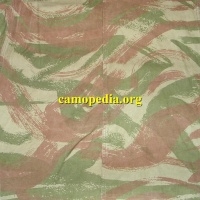
A later variation on the "Leopard camouflage" additionally included reddish-brown and olive green or red-brown and moss green on a light green base. It appeared in practice as the "Mle 1947/53 TAP" smock. This is the type designated according to the French categorization system as version "A2".

Another variation on the "Leopard camouflage" was classified by the modern French system as "B1". All colors here resemble the earlier version "A1" camouflage, which was used on improvised shelters of all types, but its internal layout and shapes changed significantly.
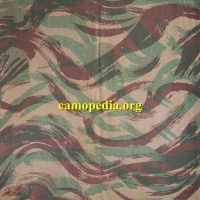
The type classified as "C1" was designated as "The Uniform for all Armed Men" ("Treillis toutes armes (TTA)").
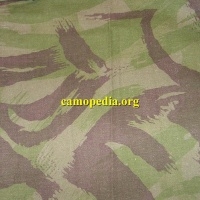
As for the camouflage pattern labeled "camouflage D," it was typically printed on shelters of all types from the Algerian period and war. The type features rust, and horizontally over it, as if light green, all on a sand background. Meanwhile, everything is printed from only one side. Historical evidence and research on this topic have shown that some elite French units had certain personal and individual items (such as ordinary berets) made from this fabric, but there is no explicit evidence that any more widespread French forces of this time were making something in genuinely large scale in precisely this color combination. Documentation also illustrates helmet covers made from this fabric for certain units (such as "3eme REI"), and even this turns out to be very localized in its deployment and is not very widespread. However, type "D" can still be found in military clothing, but also in slightly different colors.
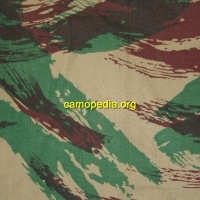
The version visible below includes wide pale shades of lichen-green and purple-brown strokes across it, all on the traditional khaki base. This is a variation on type "D" of the "Leopard camouflage," specifically intended for tropical areas. Variations appeared again as part of later "Treillis toutes armes (TTA)" or also "General military clothing".

Another variation on the "Lizard" type. Probably dates back to the Algerian War. It is something made by private tailors and is a type quite similar to the "Treillis toutes armes" version from 1958. In modern French classification, it appears under the name type "E1".
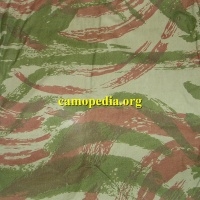
Along with introducing the final version of the French TAP / Airborne uniform and All-Arms (TTA) camouflage, came a fairly standard version of the leopard pattern. Seen below are two examples of the final version "Leopard camouflage" obtained from the "Mle 1947/56 TAP" uniform and "Tenue de combat camouflée Mle 1947 toutes armes / Mle 1958". These camouflage patterns (and their copied derivatives) are classified by the modern French system as "F1".
